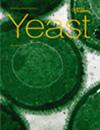裂变酵母中的异型菌株工程
IF 2.6
4区 生物学
Q4 BIOCHEMISTRY & MOLECULAR BIOLOGY
引用次数: 0
摘要
在贫氮条件下,裂殖酵母细胞进行交配、减数分裂并形成孢子,从而抵御有害环境。裂殖酵母的天然分离物是同性的。这使它们能够高频率地在两种 h- 和 h+ 交配类型之间自然切换,从而确保细胞群体中同时存在两种交配伴侣。然而,改变交配型基因座可以取消交配型切换或将其降低到非常低的频率。这种异雄性菌株已被分离出来,并因其在孟德尔遗传学中的简单应用而成为研究实验室中的常见菌株。除了标准的实验室菌株外,现在还有大量的天然 S. pombe 分离物,它们是研究裂殖酵母遗传多样性和生物学的强大资源。然而,这些菌株大多是同雄性的,要从同雄性亲本中获得异雄性细胞,只能采用繁琐或诱变的策略。在这里,我们描述了一种生成异雄性菌株的简单方法。该方法利用了之前在交配型切换缺陷菌株中发现的交配型基因座的改变以及CRISPR-Cas9编辑工具,从而实现了一步到位的高效异雄性细胞工程。本文章由计算机程序翻译,如有差异,请以英文原文为准。

Engineering heterothallic strains in fission yeast
In poor nitrogen conditions, fission yeast cells mate, undergo meiosis and form spores that are resistant to deleterious environments. Natural isolates of Schizosaccharomyces pombe are homothallic. This allows them to naturally switch between the two h− and h+ mating types with a high frequency, thereby ensuring the presence of both mating partners in a population of cells. However, alteration of the mating type locus can abolish mating type switching or reduce it to a very low frequency. Such heterothallic strains have been isolated and are common in research laboratories due to the simplicity of their use for Mendelian genetics. In addition to the standard laboratory strains, a large collection of natural S. pombe isolates is now available, representing a powerful resource for investigating the genetic diversity and biology of fission yeast. However, most of these strains are homothallic, and only tedious or mutagenic strategies have been described to obtain heterothallic cells from a homothallic parent. Here, we describe a simple approach to generate heterothallic strains. It takes advantage of an alteration of the mating type locus that was previously identified in a mating type switching-deficient strain and the CRISPR-Cas9 editing tool, allowing for a one-step engineering of heterothallic cells with high efficiency.
求助全文
通过发布文献求助,成功后即可免费获取论文全文。
去求助
来源期刊

Yeast
生物-生化与分子生物学
CiteScore
5.30
自引率
3.80%
发文量
55
审稿时长
3 months
期刊介绍:
Yeast publishes original articles and reviews on the most significant developments of research with unicellular fungi, including innovative methods of broad applicability. It is essential reading for those wishing to keep up to date with this rapidly moving field of yeast biology.
Topics covered include: biochemistry and molecular biology; biodiversity and taxonomy; biotechnology; cell and developmental biology; ecology and evolution; genetics and genomics; metabolism and physiology; pathobiology; synthetic and systems biology; tools and resources
 求助内容:
求助内容: 应助结果提醒方式:
应助结果提醒方式:


